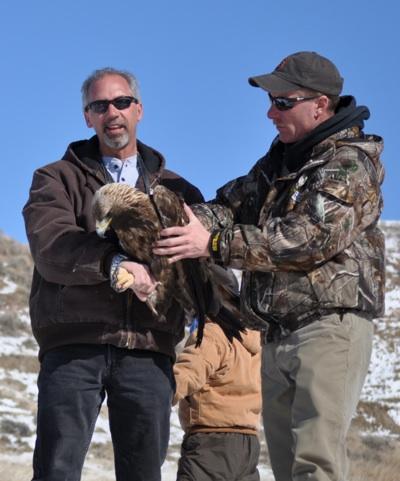Two golden eagles and one bald eagle that have been undergoing rehabilitation at a zoo have been released into Theodore Roosevelt National Park.
"We are very excited to participate in the effort to return these eagles to the wild," said Superintendent Valerie Naylor. "The park provides excellent habitat and forage for the birds. Because our elk reduction program was so successful, there is a good supply of elk meat available for them to feed on if they stay inside the park boundary."
The eagles, which were released last week into the park's South Unit, had to overcome some substantial injuries before they could take to the skies over the park. They were nursed back to health at the Dakota Zoo in Bismarck, North Dakota. The facility conducts medical treatment and rehabilitation for numerous raptors each year, specializing in endangered and threatened species, particularly eagles.
The golden eagle arrived at the Dakota Zoo shortly before Christmas. Zoo officials say the bird was found near Killdeer, North Dakota, sitting in a tree with a large amount of blood on the ground below. After being taken to the zoo by U.S. Fish and Wildlife Service staff, X-rays revealed that the bird had more than a dozen shotgun pellets throughout its body, "including one behind the right eye deep in the head."
"Several of the more shallow pellets were extracted and the bird began a 30-day regimen of treatment for lead poisoning. This involved giving the bird injections twice per day with a drug that encapsulates any free lead particles, rendering them harmless to the bird," said zoo Director Terry Lincoln. "After about three weeks the bird began opening its damaged eye fully and also proved to have a voracious appetite. After approximately six weeks, the bird was moved to a large flight pen, where it had the opportunity to exercise and strengthen its wings. Zookeepers encouraged the bird to fly several times per day and the bird proved to be an excellent flier."
Bird No. 2, a bald eagle, was taken to the zoo last August after being found north of Bismack, unable to fly. While nothing appeared wrong with the immature eagle, it was weak and thin, according to the zoo director. Force-feeding the eagle by staff was done for several days until the bird began eating on its own. It was strengthened for flying in a large flight pen.
Bird No. 3, another golden eagle, came to the zoo in April 2010. It had been captured by U.S. Fish and Wildlife staff near Minot, North Dakota. An examination revealed that it had a slightly injured wing.
"The bird ate well on its own and there was nothing that we could do for its wing injury, so it was moved to a flight pen to give it the opportunity to develop its wing muscles and possibly be able to fly again in the future," said Director Lincoln. "This bird has been encouraged to fly daily and it is such a good eater that we had to place it on a diet and special exercise program because it was a bit 'too hefty' to get off of the ground."
In the past, most releases of rehabilitated eagles in Theodore Roosevelt National Park have taken place in the spring, when prey such as prairie dogs and rabbits are more prevalent and active, park officials note. However, due to the fact that the park recently completed a successful elk reduction operation, there is a good supply of elk meat available for these birds from field-dressing of the elk.
Eagles have made a remarkable comeback in North Dakota, due in part to the outlawing of the pesticide DDT, which caused eggshells to be too thin for incubation. Once endangered, bald eagles were removed from the Endangered Species List in 2007. Both species of eagles are protected under the Bald and Golden Eagle Protection Act.




Add comment